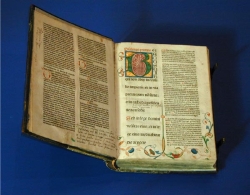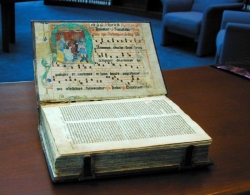
Click here for more information about the Bruno Psalter of 1475
 The Bruno Psalter of 1475 is the oldest printed book (incunabulum) at Gonzaga. The book's attractive layout presents the text of the psalms in one column alongside a second column with the commentary of Bruno, Bishop of Würzburg (d. 1045), who was learned in Greek and Hebrew. Historically this was the first work printed in Würzburg, by Reyser. As shown here, the first page of the Psalter was illuminated, that is, it was decorated by hand with gold as well as colored ink. In this way the printer continued the practice of medieval scribes of adorning the first word of the first psalm, which begins with the words "Beatus vir" (Blessed is the man...). The Bruno Psalter of 1475 is the oldest printed book (incunabulum) at Gonzaga. The book's attractive layout presents the text of the psalms in one column alongside a second column with the commentary of Bruno, Bishop of Würzburg (d. 1045), who was learned in Greek and Hebrew. Historically this was the first work printed in Würzburg, by Reyser. As shown here, the first page of the Psalter was illuminated, that is, it was decorated by hand with gold as well as colored ink. In this way the printer continued the practice of medieval scribes of adorning the first word of the first psalm, which begins with the words "Beatus vir" (Blessed is the man...). |
|
|
 In book construction, a sheet of material is "pasted down" on the inside of the cover and can extend onto the first page of the text block. In later books, in which paper is used for the pastedowns, they are usually called "endpapers." In many incunabula, however, these "pastedowns" are actually folios from medieval manuscripts. In book construction, a sheet of material is "pasted down" on the inside of the cover and can extend onto the first page of the text block. In later books, in which paper is used for the pastedowns, they are usually called "endpapers." In many incunabula, however, these "pastedowns" are actually folios from medieval manuscripts. |
|
|
Th e manuscript pastedown at the back of the Bruno Psalter is possibly from the prior page of the same antiphonary. The antiphon Te gloriosus Apostolorum is used for All Saints (November 1), and here seems to be used for November 9 as well, given that there is a reference to Theodor, who is mentioned in the Oratio for the Dedication of the Archbasilica of the Most Holy Savior (Lateran?) on November 9. Liturgical instructions are often called rubrics because of the custom of writing them in red, as seen here. [Antiphonary details from Professor Edward Schaefer] e manuscript pastedown at the back of the Bruno Psalter is possibly from the prior page of the same antiphonary. The antiphon Te gloriosus Apostolorum is used for All Saints (November 1), and here seems to be used for November 9 as well, given that there is a reference to Theodor, who is mentioned in the Oratio for the Dedication of the Archbasilica of the Most Holy Savior (Lateran?) on November 9. Liturgical instructions are often called rubrics because of the custom of writing them in red, as seen here. [Antiphonary details from Professor Edward Schaefer] |
|
The contemporary or near-contemporary binding of |
 |
 |
 |
|
|
 |
 Literal bookworms do exist and have for centuries: here is evidence of one, in the margin.
Literal bookworms do exist and have for centuries: here is evidence of one, in the margin.
Early printed books imitated the abbreviations used in manuscripts. The text shown beside the worm hole is "Ego autem in domino et non in mea iusticia, sed in fide divine protectionis gaudebo." In several places, abbreviations have been used, including a "suspension mark" above a word, to mark the omission of one or more letters, usually an m or n. An example is the word autem which appears simply as aut with a suspension mark. Names for God and the saints, nomina sacra, are frequently abbreviated. The standard abbreviation for dominus (Lord) is dn plus the final letter of the word, to indicate its grammatical case.
The volume has call number: SPEC COLL BS1425.L3B7 1475